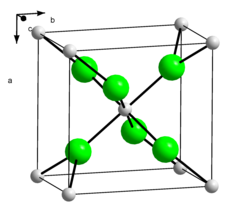Strontium chloride
| Crystal structure | ||||||||||||||||||||||
|---|---|---|---|---|---|---|---|---|---|---|---|---|---|---|---|---|---|---|---|---|---|---|

|
||||||||||||||||||||||
| __ Sr 2+ __ Cl - | ||||||||||||||||||||||
| General | ||||||||||||||||||||||
| Surname | Strontium chloride | |||||||||||||||||||||
| other names |
STRONTIUM CHLORIDE ( INCI ) |
|||||||||||||||||||||
| Ratio formula | SrCl 2 | |||||||||||||||||||||
| Brief description |
colorless to white, odorless powder |
|||||||||||||||||||||
| External identifiers / databases | ||||||||||||||||||||||
|
||||||||||||||||||||||
| Drug information | ||||||||||||||||||||||
| ATC code | ||||||||||||||||||||||
| properties | ||||||||||||||||||||||
| Molar mass | ||||||||||||||||||||||
| Physical state |
firmly |
|||||||||||||||||||||
| density |
1.95 g cm −3 (hexahydrate) |
|||||||||||||||||||||
| Melting point |
|
|||||||||||||||||||||
| boiling point |
1250 ° C |
|||||||||||||||||||||
| solubility |
|
|||||||||||||||||||||
| safety instructions | ||||||||||||||||||||||
|
||||||||||||||||||||||
| Toxicological data | ||||||||||||||||||||||
| As far as possible and customary, SI units are used. Unless otherwise noted, the data given apply to standard conditions . | ||||||||||||||||||||||
Strontium chloride is a salt of strontium . It has the formula SrCl 2 and belongs to the group of chlorides .
properties
Strontium chloride forms colorless crystals. These are hygroscopic and form a hexahydrate , the crystals of which are colorless and translucent. Strontium chloride weathers in dry air and gives off its water of crystallization above 60 ° C, so that it melts anhydrous at 873 ° C. The solution of strontium chloride in water has a pungent and bitter taste.
Manufacturing
Strontium chloride is obtained from the minerals cölestin or strontianite using hydrochloric acid (HCl). The strontium carbonate obtained from cölestin via intermediate steps or contained as the main component in strontianite reacts with the hydrochloric acid to form strontium chloride and carbonic acid , which in turn breaks down into carbon dioxide and water :
use
Strontium chloride is mainly used in pyrotechnics to color fireworks red. It is also used as an additive in the glass industry and in metallurgy .
As strontium chloride hexahydrate (SrCl 2 • 6H 2 O) , it is used in laboratory technology for the detection of other strontium compounds and in atomic absorption spectroscopy and in medicine. In some dental care products (e.g. Sensodyne Classic) it is intended to prevent periodontitis and reduce the sensitivity of the tooth necks to pain. In homeopathy it is used for similar purposes in a highly diluted form as Strontium chloratum . As a weakly radioactive isotope compound 89-strontium chloride , it is also used in cancer therapy for the treatment of pain in bone cancer when hormone therapy no longer works in advanced metastases ( radionuclide therapy ).
Strontium chloride hexahydrate is also used in seawater aquariums to provide a sufficient supply of strontium as a skeletal component of some coral species. The strontium chloride is extracted from the water , especially by hard corals, and must therefore be topped up. However, it should be noted that strontium is highly toxic to some marine life (such as crabs).
Individual evidence
- ↑ entry to STRONTIUM CHLORIDE in CosIng database of the European Commission, accessed May 4, 2020th
- ↑ a b c d e f g h i Entry for CAS no. 10476-85-4 in the GESTIS substance database of the IFA , accessed on April 6, 2016 (JavaScript required)
- ↑ Strontium chloride data sheet from AlfaAesar, accessed on April 01, 2020 ( PDF )(JavaScript required) .
- ↑ a b Strontium chloride data sheet from AlfaAesar, accessed on March 14, 2010 ( PDF )(JavaScript required) .
- ↑ Dimethyl Sulfoxide (DMSO) Solubility Data. Gaylord Chemical Company, LLC; Bulletin 102, June 2014, p. 14. (PDF)
- ↑ Robert Jay Goldstein: Marine Reef Aquarium Handbook . Barron's Educational Series, 2007, ISBN 0-7641-3674-7 , pp. 24 ( limited preview in Google Book search).
- ^ Sven Gehrmann: The fauna of the North Sea: Lower animals. Mollusks, moss animals, cnidarians ... BoD - Books on Demand, 2010, ISBN 3-9812553-2-1 , p. 125 ( limited preview in Google Book Search).
- ↑ Aquarist Magazine and Blog: Aquarium Chemistry: Strontium and the Reef Aquarium - Advanced Aquarist | Aquarist Magazine and Blog , accessed May 12, 2014
Web links
- Omikron Chemicals Lexicon ( Memento from May 7, 2012 in the Internet Archive )


